Tag: UC Berkeley Library
Workshop Reminder — How to Publish Open Access at UC Berkeley on October 17, 2023
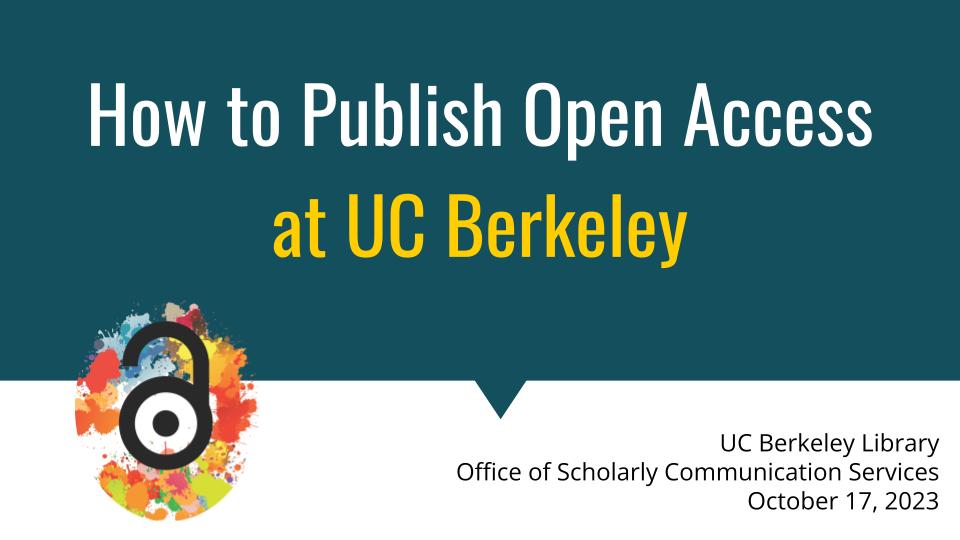
Date/Time: Tuesday, October 17, 2023, 11:00am–12:30pm
Location: Zoom only. Register via LibCal.
Are you wondering what processes, platforms, and funding are available at UC Berkeley to publish your research open access (OA)? This workshop will provide practical guidance and walk you through all of the OA publishing options and funding sources you have on campus. We’ll explain: the difference between (and mechanisms for) self-depositing your research in the UC’s institutional repository vs. choosing publisher-provided OA; what funding is available to put toward your article or book charges if you choose a publisher-provided option; and the difference between funding coverage under the UC’s systemwide OA agreements vs. the Library’s funding program (Berkeley Research Impact Initiative). We’ll also give you practical tips and tricks to maximize your retention of rights and readership in the publishing process.
Join us next week!
A Short History of Languages in the UC Berkeley Library
The Languages of Berkeley: An Online Exhibition
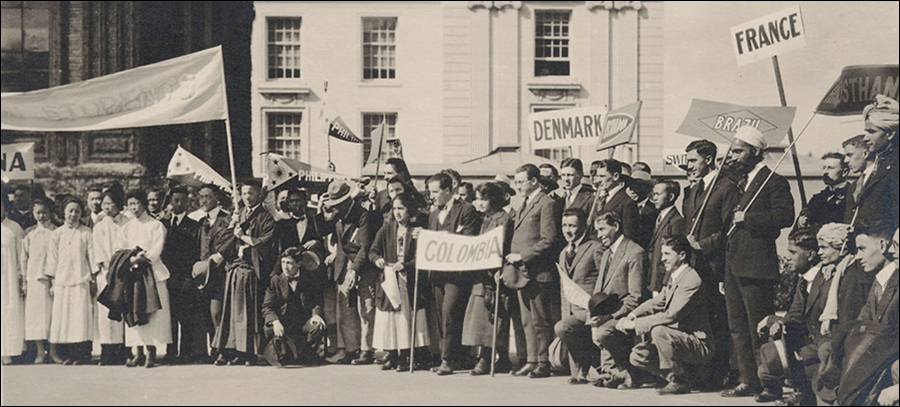
Beginnings (1868-1900)
Since the University of California at Berkeley’s founding in 1868, students and faculty have placed emphasis on other languages besides English. Its first library came from its predecessor the state-chartered College of California in Oakland. Among these 1,036 books were many written in Ancient Greek and Latin, ancient languages required for the Bachelor of Arts degree.1 The university’s founders saw the state’s future in the Pacific, towards the East, and in 1872 one of them, a San Francisco lawyer named Edward Tompkins, established the first endowed chair. The Agazzi Professorship in Oriental Languages and Literature, as it was named, was first held by John Fryer, an English sinologist who had lived in China for over 35 years.2 He placed his personal collection of Chinese texts on deposit in the Library where it remained available after his retirement. Formally given to the university after his death, it constituted the foundation for Berkeley’s prestigious Chinese collection.3 Michael Reese, a visionary financier and German immigrant who amassed his fortune during the Gold Rush of 1849, bequeathed $50,000 to the Library in 1879. The interest was to be used for the acquisition of materials in the arts, sciences and literature, establishing the Library’s very first endowment.4
Several other collections based around languages were subsequently formed. In 1880, the Library hired its first overseas agent Charles Ferdinand Reinwald to procure publications from France.5 In 1884, a professor of linguistics named Alvin Putzker, renowned for having mastered 27 languages, generously put forth his own funds to form a German collection. Located inside the newly constructed Bacon Library and Art Museum, it quickly became indispensable to students.6 An article printed in the Oakland Enquirer in 1888 describes an emerging distinctness in the printed resources with “sets of some of the great German publications from European universities and of foreign governments, of which there are some cases only one other copy, and in other cases none on the [West] Coast.”7 By 1898, Berkeley—with gifts of Semitic texts from local patrons such as Alfred Greenbaum, Louis Sloss, and Mary Avery and at least one renowned institution, Columbia University—soon possessed one of the largest collections of Jewish literature in the United States.8
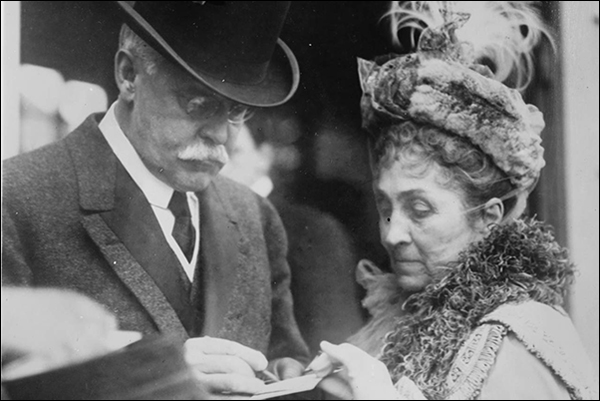
By the turn of the century, Berkeley’s collection had grown to 80,249 volumes with a defining footprint representing many of the world’s regions and languages. Dora Smith, who wrote a master’s thesis on the history of the Library up to 1900, credited the Library’s extensive collection of language materials to the valuable gifts from private individuals.9 The extraordinary philanthropist, collector, and adventurer Phoebe Apperson Hearst, the UC’s first female regent, indelibly shaped the young campus with financial support for new buildings and departments, as well as for library and museum collections.10 Besides the diverse projects in California and across the nation, she also financed major archeological excavations in Egypt, Peru, Mexico, and Europe. Two prominent archeologists were recruited: Max Uhle who specialized in the Andean region and Zelia Nuttall—a Mexican-American anthropologist from San Francisco who specialized in pre-Aztec cultures who became field director for research in Mexico. Hearst’s patronage helped established Berkeley’s reputation as one of the premier institutions for linguistics and ethnology of the Americas.11 Prescient to the sizeable Spanish language acquisitions of Cowan and Bancroft, another benefactor named James K. Moffitt made substantial contributions, urging the university “to collect and establish here [. . .] all that records or can illustrate the history and fortune of the Spanish occupation of North and South America.”12 The purchase of Hubert Howe Bancroft’s magnificent library in 1905 fulfilled that calling; it was, and remains, the largest library in the United States devoted to a single region—spanning from the Panama Canal to Alaska—enriched by Spanish language content.13 Other collections acquired during this period included that of a French banker named François L. A. Pioche had moved to San Francisco during the Gold Rush, bequeathed his private collection to Berkeley, including more than 1,500 exquisitely bound editions in French literature and linguistics.14 Benjamin Ide Wheeler, who would become president of the university from 1899 to 1918, was a Sanskrit scholar and the first to teach it at Berkeley in 1897.15 He served as chair of the Department of Linguistics in 1901, the first such department in America, which offered courses such as “The Relationship of the Indo-European, Semitic, and Egyptian Families of Languages”, and “Elementary Sanskrit.”16

Growth of Collections (1900-1950)
Under the attentive stewardship of the faculty, the Library saw another wave of growth between 1900 and 1950, exceeded only by that of the libraries at the Universities of Illinois and Minnesota.17 Paul Chambers in the Spanish Department, Lucien Foulet in the French Department, and many others, were authorized to purchase books while on research trips abroad.18 With a generous gift from the estate of General Horace W. Carpentier, the first mayor of Oakland, President Wheeler established an endowment in 1919 to develop collections in the “five great areas of Asiatic civilization, particularly China, Japan, India, Arabia and Babylon.”19 UC Berkeley became the first university in the nation to offer Mongolian thanks to Professor Ferdinand D. Lessing, author of the Mongolian-English Dictionary (UC Press, 1960), which is still considered the standard today.20 In 1936, the Department of Oriental Languages allocated $3,000 to Lessing for purchasing books in China and Japan in 1936, resulting in a notable collection in Chinese Buddhist scholarship.21 Prior to the establishment of the East Asiatic Library in 1947, other faculty including Woodbridge Bingham and Delmer Brown played indispensable roles in developing its collections by making acquisitions while on sabbatical in Asia.22
In 1901, A. L. Kroeber, a recent PhD student of the German-born American anthropologist and pioneer of modern anthropology Franz Boas, initiated the Archaeological and Ethnographic Survey of California within the Department of Anthropology.23 Also funded by Phoebe Hearst, this project included documentation of the indigenous languages of California, including Achumawi, Huppa, Yanna and the Ohlone languages. Throughout the 20th century, other prominent anthropologists immersed themselves in languages such as Aymara, Quechua, Bantu, Siamese (Thai), Vietnamese, and Dravidian and Sino-Tibetan languages, requiring the library to expand its world languages collections. In the same year, the Department of Slavic Languages and Literatures was founded, which led to the beginning of Russian language instruction on campus.24 In 1910, Henry Morse Stephens, a professor in the Department of History with professional and personal ties to South Asia, began a series of book buying trips to England and India. He bequeathed his vast collection to the University Library in 1919, laying the foundation for Berkeley’s extensive holdings from South Asia.25
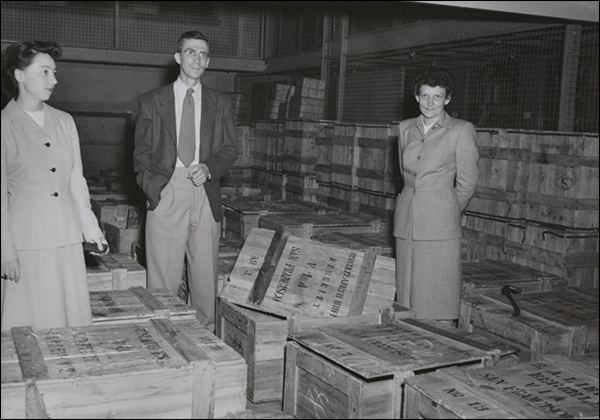
One deliberate strategy to further strengthen the young University Library’s holdings was through en bloc acquisitions of collections by purchase or gift from individuals, institutions or governments. Prominent among these was a collection from Kiang Kang-hu—an instructor of Chinese who pledged his grandfather’s library of 13,600 volumes to the university in 1914.26 Shipped from Beijing where it was secured in a Buddhist Temple, the collection is now housed in the C. V. Starr East Asian Library (formerly the East Asiatic Library), which collects principally in Chinese, Japanese, and Korean languages. Berkeley’s Library constitutes one of the three largest East Asian collections in the country and maintains smaller historical collections in the Manchu, Mongolian, and Tibetan languages.27 The first significant collection of Japanese materials acquired was the library of emeritus professor Yoshi Saburo Kuno following his death in 1941.28 Larger acquisitions came in the late 1940s, when Tokyo-born bibliographer for Japanese Elizabeth McKinnon would travel to Japan to purchase books needed by Berkeley’s growing literature and history faculty. The acquisition of the Murakami library contributed 11,000 volumes in literature and social sciences, while that of the Mitsui clan brought more than 100,000 items in Japanese as well as Chinese and Korean.29 Founder of the Department of Political Science in 1903 and contributor to the Library, Bernard Moses was Berkeley’s earliest Latin Americanist and taught the first course in Latin American history on any college campus in the United States.30 The Library’s Italian collection was primarily seeded by two notable gifts. One came in 1912 from the estate of a beloved romance languages instructor Marius Spinello who lost his life tragically at the age of 30, and another in 1924 of over 700 volumes from Mark J. Fontana, an Italian immigrant who founded the California Fruit Canners Association.31 In 1917, the French Government presented UC Berkeley with the Library of French Thought, a collection of 2,500 volumes in literature, philosophy, and science, when the collection could not safely return to France following the close of the Panama-Pacific International Exposition in San Francisco.32 The first first professor of Semitic languages and literature, Rabbi Jacob Voorsanger, donated approximately 1,800 volumes in the field of Semitics in 1919.33 Despite the trials of the Great Depression, the university managed to secure the private library of exiled Russian statesman and historian Paul Miliukov, with works mostly in Russian, Bulgarian, Serbian, and other Cyrillic-alphabet languages and described as “one of the best private collections of Russian History and civilization outside of Slavic Europe.”34
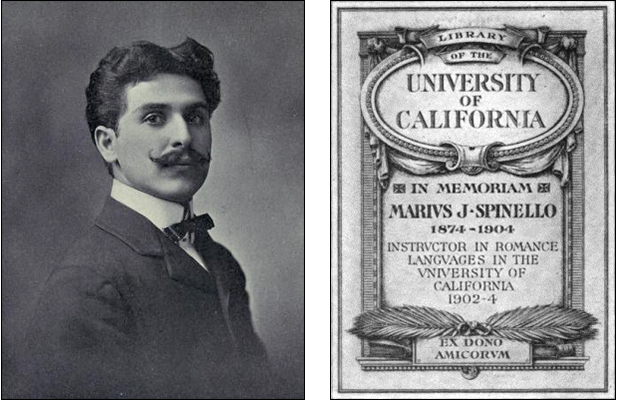
The accomplishments of the Library during the first half of the 20th century required extraordinary cooperation among book dealers, donors, faculty, librarians, and campus administrators alike. During World Wars I and II, the Library negotiated arrangements with foreign dealers to store subscription materials until the end of hostilities, using reserve funds to pay for them once they became available.35 The Library Committee of 1930, composed of faculty representing the various disciplines, conducted a survey of the collection in order to determine its basic needs. The result was a policy statement approved by the Academic Senate in 1931 which outlined fields in which the university sought national preeminence. Of particular relevance to regions and languages were the history and literature of Southwest America, Latin America and Spain, the history of Modern Europe, Russian language and literature and general history of Russian, Italian literature and history. Other geographic areas of study designated as relatively undeveloped but needing “energetic support” at that time included Dutch, Scandinavian, Slavic, Middle Eastern, Indian, Malayan, and Celtic languages, literatures, and history. Publications in Celtic languages such as Welsh, Irish, Breton, and Scottish Gaelic were collected, principally by instructors, to support teaching on the campus as early as 1909.36 First offered in 1942, Korean now has a curriculum that includes elementary through-advanced language instruction as well as courses in Korean poetry and prose.37
Another avenue for building world language collections was through relationships with international universities, a practice that had already begun in the 19th century due to the pioneering efforts of University Librarian Joseph Cummings Rowell. “By 1887, correspondence with nearly one hundred foreign universities had been started with a view to increasing the exchanges which were already proving to be of great value,” observed Smith.38 By the mid-1930s, the Library was receiving through exchange more than 4,000 serials titles annually from 77 foreign countries.39 By 1943, 635 serials were being received from Spanish-speaking countries of South America, 100 from Brazil, 130 from Mexico, and 40 from Central America.40 Responding to the research interests of faculty, the program resumed after World War II and grew to over 4,000 partners by 1990, making it the largest such program among U.S. academic libraries. Annually, the exchanges contributed 5,000 monographs and nearly twenty percent of all extant serial titles to the collection.41 In 2001, Africana librarian Phyllis Bischof and Frank Carothers, Gifts and Exchange coordinator, co-curated a library exhibit entitled “International Exchange and the Library” that highlighted the crucial role that gifts and exchange played in establishing the prestige of Berkeley’s international collections.42 The forces of supply and demand bolstered the physical exchanges for all regions of the world. By 2015, however, most were dismantled at Berkeley primarily due to rising costs of maintaining the program and the ease of access to many of the serials through advances in web technologies and open access in particular.
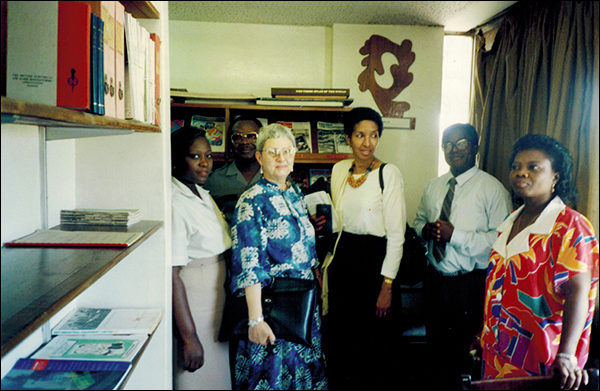
Global and Cooperative Collecting (1950 to present)
Like most American research libraries in the second half of the 20th century, the UC Berkeley Library saw the steadiest period of growth of its collections. The California Master Plan for Higher Education was developed in 1960, with UC campuses focusing on research-intensive disciplines in the liberal arts and sciences. This, in turn, led to unprecedented growth for library collections.43 As public funding for budgets peaked, staff sizes increased and area/regional specialists played more important roles in shaping and providing services to the collections. During this period of unprecedented internationalism, the Association of Research Libraries (ARL) sponsored large-scale cooperative collecting agreements such as the Farmington Plan (1948-1972), a national consortium of North American research libraries. Later, institutional members of the Research Libraries Group (RLG) formalized their area strengths by focusing collecting by region, discipline and language.44 The Plan’s successor, known as the Conspectus, began in 1982 and waned by the late 1990s. Material budgets for non-English languages in the libraries of public institutions such as Berkeley were further bolstered beginning in 1958 by the U.S. Department of Education’s Title VI National Resource Centers (NRCs), which were created to increase the nation’s capacity in foreign language and area studies, specifically during the Cold War (1947-1991).45 The NRCs, together with the Foreign Language and Area Studies Fellowships (FLAS) program, critically enhance teaching and learning of modern foreign languages, especially less commonly taught languages. In the last grant cycle UC Berkeley received funding for all regions of the world.46 Title VI funds have supported the Library with staffing, collections-related travel, and enrichment funds for language collections.
Another dependable federal partner for overseas acquisitions has been the Library of Congress, an agency of the legislative branch and the largest library in the world. Since 1962 it has maintained offices abroad to acquire, catalog, preserve, and distribute library and research materials from countries where such materials are essentially unavailable through conventional acquisitions methods.47 In addition to serving the needs of the physical library in Washington D.C., the overseas offices based in Cairo, Islamabad, Jakarta, Rio de Janeiro, Nairobi and New Delhi maintain a Cooperative Acquisitions Program (CAP) for over 100 American research libraries including Berkeley. These have been essential in growing the university’s formidable international collection for regions of the world that are politically unstable or lack in-country vendors and reliable distribution channels.
![Miền Nam 1967 [newspaper]](https://update.lib.berkeley.edu/wp-content/uploads/2020/09/mien-nam.jpg)
By the late 1980s, the RLG Conspectus had begun to wane and yet, motivated by declining library budgets and rising costs of materials, new agreements rose to take its place. Most of these agreements were regional in nature, such as those between the libraries of Stanford and UC Berkeley established in the late 1970s and early 1980s for African, Slavic, and Latin American Studies. Leveraging the Research Library Cooperative Program (RLCP) signed in 1998, which enhanced interlibrary lending with Stanford and included the University of Texas, Austin, more than a dozen additional bilateral agreements between Stanford and Berkeley.50 Principally for geographic areas, these were added to the list and formalized by university librarians Tom Leonard and Michael Keller. The goal of these cooperative agreements was to enable both institutions to provide access for their users to broader and deeper collections of materials in the fields covered. “In this way,” the agreement states, “each institution can devote more resources and efforts to building holdings in its areas of greatest strength, while relying upon the partner to build similarly strong collections in its own areas of concentration.”51 Coordinated through the California Digital Library, Berkeley also participates in several consortial shared print initiatives such as the Western Regional Storage Trust (WEST) and the Journal Archiving Campaign Service (JACS), which allow UC and other participating libraries to optimize storage space while broadening and ensuring long-term access to legacy print holdings.52

Departments, Programs, and National Resource Centers
Berkeley’s preeminence in the study, teaching and use of languages besides English is reflected not only in its departments but also in nine international and area studies and research centers and institutes which receive Title VI funding: the Center for African Studies (CAS), the Institute of East Asian Studies (IEAS), the Institute of European Studies (IES), the Institute of International Studies (IIS), the Center for Latin American Studies (CLAS), the Center for Middle Eastern Studies (CMES), the Institute of Slavic, East European and Eurasian Studies (ISEEES), the Institute for South Asia Studies (ISAS), and the Center for Southeast Asia Studies (CSEAS). The Berkeley Language Center (BLC), founded in 1994, is a unit in the Division of Arts & Humanities of the College of Letters & Science that directly supports the learning and teaching of some 60 modern and ancient languages on the campus and beyond.53
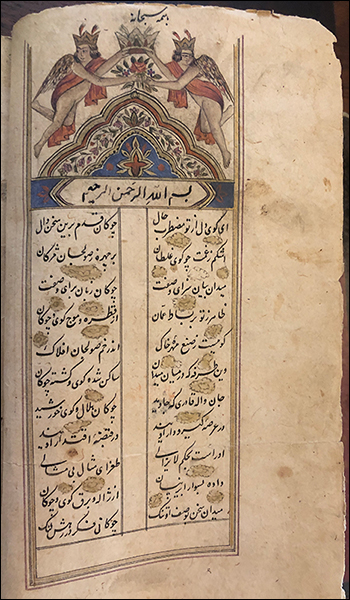
Founded in 1894 as the Department of Semitic Languages, Berkeley’s Near Eastern Studies Department, is one of the oldest and most distinguished in the country.54 Students and faculty work in Arabic, Hebrew, Kurdish, Persian, Turkish, and comparative Semitics, choosing interdisciplinary programs in Archaeology, Art History, Assyriology, Egyptology, Iranian Studies, Judaic and Islamic Studies. The establishment of the Center for Middle Eastern Studies in 1963 further expanded the scope and breadth of the program on campus, raising public awareness of the region’s linguistic and cultural diversity.55 The Library’s distinct holdings for this part of the world concentrate on regions of the Middle East and the Maghreb including Morocco, Libya, Egypt, Sudan, Syria, Jordan, Iraq, Iran, Palestine, and Israel as well as both modern and ancient languages including Akkadian, Ancient Egyptian, Coptic, Sumerian, and Syriac. Rare manuscripts are housed in The Bancroft Library, and the Center for the Tebtunis Papyri holds the largest collection of papyrus texts in the Americas.56
Jewish Studies has deep roots at UC Berkeley, from its first Hebrew courses, in the 1890s, to the current interdisciplinary study of Jewish languages, literature, history and culture worldwide.57 Jewish Studies marked its second century at Berkeley with the establishment of the UCB-GTU Doctoral Program in Jewish Studies (1995-2013), which produced a new generation of leading scholars. Today, the Center for Jewish Studies provides an undergraduate Minor and a graduate Designated Emphasis in Jewish Studies, with courses throughout the UCB departments.58 Academic and cultural programs are conducted in collaboration with the Berkeley Institute of Jewish Law and Israel Studies (with its fellowship and visiting scholar programs) and the Magnes Collection of Jewish Art and Life (through its substantial art, music, and historical holdings on the global Jewish diaspora).59 The UCB Library supports this work, with a Jewish Studies Collection spanning classical Jewish, Modern Hebrew and Yiddish literature, Jewish thought, and Jewish history throughout the ages. Comprising over 250,000 volumes, the Collection is true to its roots in the languages, with volumes in Hebrew, Yiddish, Ladino, Judeo-Arabic, nearly every European language, as well as works in Chinese, Japanese, Hindi, and more.
The primary locus of research and instruction on Africa is in the program in African American Studies and departments such as Anthropology, French, Gender & Women’s Studies, History, Linguistics, and Political Science. If there is a home for the interdisciplinary field, it is the Center for African Studies which was established in 1979 as a Title VI National Resource Center. With some exceptions, materials in the languages from Sub-Saharan Africa were not decisively acquired after World War II. One of the most significant acquisitions came from anthropologist William Bascom and his wife Bertha, who worked for more than 40 years among the Yoruba in Nigeria.60 Other African languages taught and collected at Berkeley over the years include other Niger-Congo languages such as Swahili, Chichewa and Wolof as well as Amharic, Hausa, Somali, Zulu, and Afrikaans. Scholarly interests of faculty in the Department of Anthropology guided much of the Africana collecting during this period. During the peak of the Cold War in the 1960s, academic and political interest in Africa soared, prompting growth of African Studies programs and centers at U.S. academic institutions such as Berkeley.61 For such a vast and complex region where few commercial vendors could reach, the Library established productive exchange programs with 120 libraries, archives, universities and research institutions.62 Following the period after which many African colonies had won independence, librarians such as Lee Petrasek and his successor Phyllis Bischof embarked on field acquisitions trips to survey the publishing and book trade.63 Opened in 1966, the Library of Congress Nairobi office was the last overseas office to supply U.S. libraries in 1992. Before that time, the Library relied primarily on exchanges and less than a handful of bookshops and vendors on the continent.64
While Indonesian, Thai and Vietnamese were taught on campus to intelligence officers headed for the Pacific during World War II, the Southeast Asian studies program was not inaugurated until 1954. With start-up funding from the Ford Foundation, it met both a national need and extensive interest in Southeast Asia at UC Berkeley.65 The Center for Southeast Asia Studies (CSEAS) was founded shortly thereafter, in 1960, for the development of research and teaching on the countries of Southeast Asia. Language instruction resumed primarily for the same three strategic languages taught 20 years earlier.66 Professor Mary Rosamond Haas, who taught Thai and linguistics in the Department of Linguistics from 1943 to 1977 wrote the Thai-English Student’s Dictionary (Stanford University Press, 1964), which is still considered the definitive work for Thai languages studies.67 Since 1972, the Department of South and Southeast Asian Studies has offered a variety of courses in South and Southeast Asian civilizations, languages, literature and religious studies. By 1959 the Library’s Southeast Asian collections had grown to more than 400,000 volumes and are among the finest in the world.68 The Library collects vernacular materials principally in Burmese, Hmong, Indonesian, Khmer, Lao, Malay, Tagalog, Tetum, Thai, and Vietnamese as well as western European languages related to Southeast Asian studies. Because few vendors operate in the region, the LC Cooperative Acquisitions Program on Southeast Asia based in Jakarta, Indonesia, has played a vital role in acquisitions as have generous donors such as the Swift Family who bequeathed to the university a collection of priceless Buddhist and Hindu palm leaf manuscripts.69
Historically, UC Berkeley has collected extensively on South Asia, especially from the region itself, which has resulted in the largest South Asia collection on the West Coast. It acquires publications not only in English and other European languages, but crucially also in many of the prevalent South Asian languages such as Hindi, Urdu, Tamil, Bengali, Panjabi, Telugu, Nepali, Sanskrit, Pali, and Indo-Persian among others. More than 60 faculty from a wide range of academic departments are affiliated with the Institute for South Asia Studies, founded in 1959 and one of the world’s leading institutes on the region. Founded in 1972, the Department of South and Southeast Asian Studies offers academic programs of undergraduate and graduate instruction in the languages and civilizations of South and Southeast Asia from the most ancient period to the present. Since the 1990s, enrollment in South Asian courses has skyrocketed due to a combination of the number of South Asian-American students at Berkeley as well as the increasing importance of global perspective across different disciplines.70 Recently, Berkeley Sanskrit scholars Robert and Sally Goldman completed a monumental English translation of the seven-volume The Rāmāyaṇa of Vālmīki, a 2,000-year-old epic which tells the story of Rāma, an avatar of Vishnu.71 Precious items such as Kalpasutra and Kalakacharya—a 16th century illustrated Jain manuscript—and Safīnah-i ghazal—a collection of poems in Indo-Persian from the 17th or 18th century can be found in The Bancroft Library.72
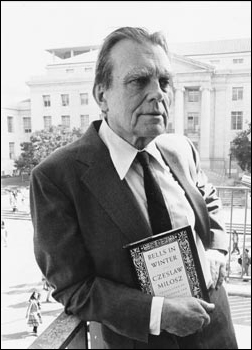
The highest concentration of faculty who work on Eastern European and Russian topics is in the Department of Slavic Languages and Literatures. Slavic Studies is equally supported and organized by the Institute of Slavic, East European and Eurasian Studies. Known prior to 2000 as the Center for Slavic and East European Studies, it has been a National Resource Center continuously since 1959.73 The UC Berkeley Library contains one of the largest Slavic collections among US academic libraries, with the majority of the collection supporting the study of Russia, its history and culture. Other noteworthy collections exist in Polish, Czech, Hungarian, Bosnian/Croatian/Serbian, Armenian and Mongolian.74 Through robust exchange agreements with academies and national libraries in the Caucasus and Central Asia, the Library has amassed solid collections for these regions and continues to do so to support increased campus interest in these subject areas.75 One of the Department’s most renowned professors was Czeslaw Milosz, a Nobel prize-winning poet who joined the Department of Slavic Languages and Literature in 1960 after defecting from communist Poland. He recounted in 1987 how he consulted as sources of creative inspiration the Library’s unique collection of Lithuanian encyclopedias, primary sources containing his personal family tree, and German ordnance maps on which he located the house where he was born.76
From the history of science to gender studies to music, Western European languages are integral to so many of Berkeley’s academic programs. The campus is one of twelve European NRCs nation-wide and in 1990, the Federal Republic of Germany chose Berkeley as one of the original three “Centers of Excellence” in the United States with the goal of fostering American understanding of contemporary developments in Europe.77 This resulted in the establishment of the Institute of European Studies (IES) in 1999 which now unifies the staff, resources, and programs of the Center for German and European Studies (CGES) and the Center for Western European Studies (CWES), which housed the France-Berkeley Fund, French Cultural Studies Program, Finnish Studies Program, Italian Studies Program, Portuguese Studies Program, and Spanish Studies Program. In 2015, the Finnish Studies Program merged into a newly formed Nordic Studies Program and the Italian Studies Program was reformed as the Program for the Study of Italy. In 2016, The BENELUX Program was founded and following a visit by President Michael D. Higgins of Ireland, an Irish Studies Program was created.78 Approximately 225 faculty are affiliated with IES from virtually every department in the College of Letters & Science. Since 1964, The Library has been a depository for documents from the European Union, and some of university’s most cherished possessions are medieval manuscripts and more than 400 incunabula, all safeguarded in The Bancroft Library’s vault.79
The Center for Latin American Studies was established in 1965 and its roster of nearly 100 affiliated faculty reflects the breadth and diversity of current interdisciplinary scholarship.80 Outside of Anthropology, History and Political Science, Latin America-related courses have become central to academic programs in Comparative Literature, Ethnic Studies, Geography, Linguistics, Gender & Women’s Studies, History, Sociology, and Spanish & Portuguese. Post-WWII generations of Latin Americanists, including intellectuals in exile such as Argentine historian Tulio Halperín Donghi who taught in the Department of History from 1971 through 1994, have had an impact on the Library’s and the campus’s preeminence in the field.81 Countless others have shaped the collection with their regional expertise and many have donated their personal libraries. Among the many visiting luminaries are writers Isabel Allende, Julio Cortázar, Diamela Eltit, Octavio Paz, and Nobel Peace Prize winner Rigoberta Menchú. Berkeley’s collection for Argentina is one of the most comprehensive in North America. The combined collections for Mexico of Bancroft and the Main library, which includes materials in Nahuatl, Opata, Tzeltal, Quiche, Tzutujil, Cakchikel, Pocoman, Ixil, Zapotec, Mixtec, Otomí, Pima, Choco, and other indigenous languages, are considered to be the deepest such holdings outside of Mexico.
Conclusion
Beginning at its inception, the UC Berkeley Library has collected and preserved materials in a diverse array of languages in support of teaching and research on the campus. As a result, today it boasts a collection of more than 13 million volumes, with approximately one-third of those resources in more than 500 non-English languages. These linguistic riches are essential resources not only for the students and faculty at Berkeley but also for scholars across the country and throughout the world. Regrettably, over the past two decades, Berkeley’s esteemed non-English language collections have become increasingly more difficult to sustain. The expense of acquiring, cataloging, providing access to, and preserving vernacular materials published in the global South, East Asia, Russia, the post-Soviet states, and Western Europe—all regarded as low-use in comparison to the more heavily consulted materials in English—threatens their place on library shelves. They are further put at risk by a steady decline in funding for public institutions like UC Berkeley, particularly in light of the economic impact of the Coronavirus pandemic.
As institutions of higher education across the country face economic challenges, it is important to remember that languages other than English are taught, studied, and used in academia not as an end in themselves. Diverse languages are studied and collected because it is through languages other than our own, and the realities described in their differing structures, that we can fully comprehend and appreciate the complex world of knowledge in any given field. As Berkeley professor Judith Butler articulated so eloquently during her keynote lecture for this exhibit’s reception: “If we were only to work in English, we would misunderstand our world.” “The passage through humility,” she said, “gives us greater capacity to live and think in a multilingual world, to shift from one way of knowing to another.”82 This multilingual experiment is what we’ve been doing at Berkeley for more than 150 years. With less than three percent of the works published in the United States being works in translation, it is troubling to envision what the scholarly universe might look like if library collections are restricted to only materials in the English language, or to conceive the scope of the discoveries and exchanges of ideas that might be lost at Berkeley and elsewhere.83
Contribution by Claude Potts
Librarian for Romance Language Collections, Doe Library
Special thanks to readers
José Adrián Barragán-Álvarez
Fedora Gertzman
Jennifer Nelson,
and Matthew Schmitz
Sources cited:
- Dora Smith, “History of the University of California Library to 1900,” (Master’s thesis, University of California, Berkeley, 1928). 21.
- “About EALC-Our Mission and History,” Department of East Asian Languages and Cultures. University of California, Berkeley. https://ealc.berkeley.edu/about/about-ealc (accessed 8/26/20)
- Doris Sze Chun, “John Fryer, the First Agassiz Professor of Oriental Languages and Literature, Berkeley,” Chronicle of the University of California 7 (Fall 2005): 1. Full text online at https://cshe.berkeley.edu/publications/changing-places-scholars-here-and-abroad (accessed 8/26/20)
- “Growth of the Collections,” UC Berkeley Library History Room, University of California, Berkeley. https://www.lib.berkeley.edu/historyroom/panel5.html (accessed 8/26/20)
- Smith, 102.
- Ibid., 43.
- Ibid., 105.
- Ibid., 124.
- Ibid., 108.
- Kathryn P. Hearst, “Phoebe Apperson Hearst: The Making of An Upper-Class Woman, 1842-1919,” (PhD diss., Columbia University, 2005), 308. ProQuest (AAT 3174808).
- Ibid., 308.
- Ibid., 46.
- Deborah Rudolph, Impressions of the East: Treasures from the C.V. Starr East Asian Library, University of California, Berkeley. (Berkeley: Heyday Books, 2007), 6.
- Smith, 110.
- “South Asian Studies,” A Hundred Harvests: The History of Asian Studies at Berkeley. Online Library exhibition, University of California, Berkeley. https://guides.lib.berkeley.edu/hundredharvests/south-asian-studies (accessed 8/26/20)
- “History of Berkeley Linguistics,” Department of Linguistics, University of California, Berkeley. https://lx.berkeley.edu/about/history-berkeley-linguistics (accessed 8/26/20)
- Kenneth G. Peterson, The University of California Library at Berkeley 1900-1945, (Berkeley: University of California Press, 1970), 6.
- Ibid., 65.
- Ibid., 36.
- “Mongolian Studies at Berkeley,” Institute of East Asian Studies, University of California, Berkeley. https://ieas.berkeley.edu/centers/mongolia-initiative-mi/mongolian-studies-berkeley (accessed 8/26/20)
- Peterson, 66.
- Deborah Rudolph, “Classical Chinese,” The Languages of Berkeley: An Online Exhibition, The Library, University of California, Berkeley. https://update.lib.berkeley.edu/2020/06/01/classical-chinese (accessed 8/26/20)
- “History of Berkeley Linguistics”
- “Slavic, East European, and Eurasian Studies at Berkeley,” Institute of Slavic, East European, and Eurasian Studies, University of California, Berkeley. https://iseees.berkeley.edu/slavic-east-european-and-eurasian-studies-berkeley (accessed 8/26/20)
- “South Asian Studies”
- Rudolph, Impressions of the East, viii.
- Ibid., ix.
- “Yoshi Saburo Kuno, Oriental Languages: Berkeley,” University of California: In Memoriam, 1941. Calisphere, California Digital Library, University of California. http://texts.cdlib.org/view?docId=hb3199n7tr&doc.view=frames&chunk.id=div00005&toc.depth=1&toc.id (accessed 8/26/20)
- Rudolph, ix.
- James E. Watson, “Bernard Moses: Pioneer in Latin American Scholarship,” The Hispanic American Historical Review 42, no. 2 (1962): 216. JSTOR, www.jstor.org/stable/2510298 (accessed 8/26/20)
- J.C. Rowell, “The Red Letter Annals of the Library,” University of California Chronicle 14 (1912): 348 and Peterson, 77.
- Peterson, 75.
- Ibid., 77.
- Wojciech Zalewski and David Sedik, “The Miliukov Collection. Early Collecting of Russica in California Academic Libraries,” Libri, 34 (1984), 186-197. doi: https://doi.org/10.1515/libr.1984.34.1.186
- Peterson, 51.
- “History of Celtic Studies at UC Berkeley,” Celtic Studies Program, University of California, Berkeley. https://celtic.berkeley.edu/celtic-studies-at-berkeley (accessed 8/26/20)
- “East Asian Studies,” A Hundred Harvests: The History of Asian Studies at Berkeley. Online Library exhibition, University of California, Berkeley. https://guides.lib.berkeley.edu/hundredharvests/east-asian-studies (accessed 8/26/20)
- Smith, 126.
- Peterson, 90.
- Ibid., 91.
- Frank Carothers, “International Exchange and the Library,” CU News 57, no. 2 (January 18, 2001). https://www.lib.berkeley.edu/AboutLibrary/CUNews/cu_011801.html (accessed 8/26/20)
- Ibid.
- California Master Plan for Higher Education,” University of California, Office of the President. https://www.ucop.edu/institutional-research-academic-planning/content-analysis/academic-planning/california-master-plan.html (accessed 8/26/20)
- Ralph Dinsmore Wagner, “A History of the Farmington Plan,” (PhD diss., University of Illinois at Urbana-Champaign, 2000), abstract. (accessed 8/26/20)
- “The History of Title VI and Fulbright-Hays: An Impressive International Timeline,” International Education Programs Service, U.S. Department of Education. https://www2.ed.gov/about/offices/list/ope/iegps/history.html (accessed 8/26/20)
- “Awards: FY2018-2021,” National Resource Centers Programs, U.S. Department of Education. https://www2.ed.gov/programs/iegpsnrc/awards.html (accessed 8/26/20)
- “Overseas Offices,” Cataloging and Acquisitions, The Library of Congress. https://www.loc.gov/acq/ovop/ (accessed 8/26/20)
- “Global Resources Programs,” Center for Research Libraries. https://www.crl.edu/collaborations/global-resources-programs (accessed 8/26/20)
- “History of CRL,” Center for Research Libraries. https://www.crl.edu/about/history (accessed 8/26/20)
- “Stanford signs agreement with two other university libraries,” News Release, Stanford University (February 4, 1998). https://news.stanford.edu/pr/98/980204libecoop.html (accessed 8/26/20)
- Cooperative Collection Development Agreement Between the Libraries of Stanford University and the University of California, Berkeley. October 8, 2012. https://www.lib.berkeley.edu/sites/default/files/stanford-berkeley-signed-agreement.pdf (accessed 8/26/20)
- “Shared Print,” Collection Development and Management, California Digital Library, University of California. https://cdlib.org/services/collections/sharedprint/ (accessed 8/26/20)
- “About the BLC,” Berkeley Language Center, University of California, Berkeley. http://blc.berkeley.edu/about_the_blc/ (accessed 8/26/20)
- “About the Department,” Department of Near Eastern Studies, University of California, Berkeley. https://nes.berkeley.edu (accessed 8/26/20)
- “Title VI National Resource Center,” Center for Middle Eastern Studies, University of California, Berkeley. https://cmes.berkeley.edu/title-vi-national-resource-center (accessed 8/26/20)
- The Center for the Tebtunis Papyri, The Bancroft Library, University of California, Berkeley. https://www.lib.berkeley.edu/libraries/bancroft-library/tebtunis-papyri/about-tebtunis-collection (accessed 8/26/20)
- Center for Jewish Studies, University of California, Berkeley. https://jewishstudies.berkeley.edu/about/tradition-of-jewish-studies-at-ucb (accessed 8/26/20)
- Center for Jewish Studies, University of California, Berkeley. https://jewishstudies.berkeley.edu/courses-degree-programs/academic-degree-programs (accessed 8/26/20)
- “Collections,” The Magnes Collection of Jewish Art and Life, University of California, Berkeley. https://magnes.berkeley.edu/collections (accessed 8/26/20)
- Phyllis Bischof, Africana library collections, University of California, Berkeley. (Berkeley, CA: Center for African Studies and The Library, University of California, Berkeley, 1993.), 12.
- Jason M. Schultz, forthcoming. “Africana Collections at the University of California, Berkeley: A History Since 1960,” in Collecting Africa in U.S. Libraries: From Collection Development to the Digital Age. (Bloomington, Indiana: Indiana University Press), 6.
- Ibid., 20.
- Ibid., 3.
- Ibid., 20.
- “Southeast Asian Studies,” A Hundred Harvests: The History of Asian Studies at Berkeley. Online Library exhibition, University of California, Berkeley. https://guides.lib.berkeley.edu/hundredharvests/southeast-asian-studies (accessed 8/26/20)
- Ibid.
- Ibid.
- Ibid.
- “Finding Aid to the Swift Family Collection of Palm Leaf Manuscripts, 1782-1898,” The Bancroft Library, University of California, Berkeley. Online Archive of California. https://oac.cdlib.org/findaid/ark:/13030/hb1z09n6x3 (accessed 8/26/20)
- “Southeast Asian Studies”
- The Rāmāyaṇa of Vālmīki: An Epic of Ancient India. Introduction and translation by Robert P. Goldman; annotation by Robert Goldman and Sally J. Sutherland. Princeton, N.J.: Princeton University Press, 1984-2017.
- “South Asian Collections,” A Hundred Harvests: The History of Asian Studies at Berkeley. Online Library exhibition, University of California, Berkeley. https://guides.lib.berkeley.edu/hundredharvests/south-asian-collections (accessed 8/26/20)
- “National Resource Center,” Institute of Slavic, East European, and Eurasian Studies, University of California, Berkeley. https://iseees.berkeley.edu/national-resource-center (accessed 8/26/20)
- Allan Urbanic and Beth Feinberg, eds., A Guide to Slavic Collections in the United States and Canada. (New York: Routledge, 2012), 114.
- “Slavic and East European Studies: Library Research Guide,” The Library, University of California, Berkeley. https://guides.lib.berkeley.edu/subject-guide/53-Slavic-East-European-Studies
- Ewa Czarnecka and Aleksander Fiut; translated by Richard Lourie, Conversations with Czeslaw Milosz. (San Diego: Harcourt Brace Jovanovich, 1987), 238.
- “History,” Institute of European Studies, University of California,Berkeley. https://ies.berkeley.edu/history (8/26/20)
- Ibid.
- “Rare Books and Literary Manuscripts,” The Bancroft Library, University of California, Berkeley, https://www.lib.berkeley.edu/libraries/bancroft-library/rare-books-collection (accessed 8/26/20)
- CLAS: A National Resource Center,” Center for Latin American Studies, University of California, Berkeley. https://clas.berkeley.edu/clas-national-resource-center (accessed 8/26/20)
- “Tulio Halperin Donghi (1926–2014),” Hispanic American Historical Review 95, no.3 (2015): 494. https://read.dukeupress.edu/hahr/article/95/3/493/36438/Tulio-Halperin-Donghi-1926-2014 (accessed 8/26/20)
- Judith Butler, “The Promise of Multilingualism,” keynote lecturer for reception. Morrison Library, February 5, 2020. The Languages of Berkeley: An Online Exhibition, The Library, University of California, Berkeley. https://update.lib.berkeley.edu/2020/04/27/the-promise-of-multilingualism-by-judith-butler (accessed 8/26/20)
- “About,” Three Percent: A Resources of International Literature at the University of Rochester. http://www.rochester.edu/College/translation/threepercent/about (accessed 8/26/20)
The Languages of Berkeley is a dynamic online sequential exhibition celebrating the diversity of languages that have advanced research, teaching and learning at the University of California, Berkeley. It is made possible with support from the UC Berkeley Library and is co-sponsored by the Berkeley Language Center (BLC).
Follow The Languages of Berkeley!
Subscribe by email
Contact/Feedback
ucblib.link/languages
![The Languages of Berkeley [fan]](https://update.lib.berkeley.edu/wp-content/uploads/2019/02/fan_languages-450px.jpg)